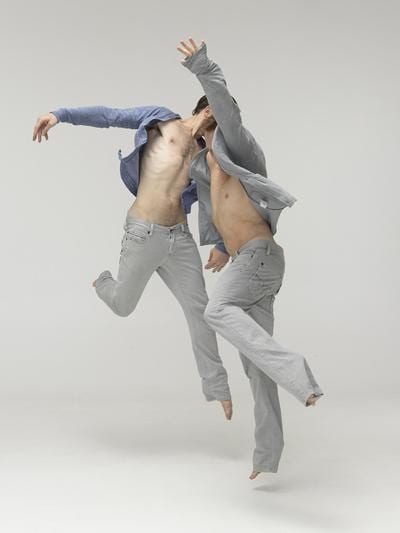Louis Laberge-Côté has never been so happy to be in Toronto. The Quebec-born dance artist has had a blast the last two years performing with the Mannheim Ballet, but the opportunity to showcase his talents on an international stage came with a caveat: being away from his husband, Toronto dancer Michael Caldwell, for most of their three-year marriage. Perhaps because the pair are touring veterans, the time apart didn’t seem to faze them. They picked up right where they left off two years ago when Laberge-Côté returned.
“We’ve been going to nice restaurants, making decadent dinners and drinking a lot of expensive wine,” he laughs. “It’s like being back in the romantic first moments of the relationship, which isn’t something you usually get to live with the same person twice.”
Laberge-Côté has also integrated rather seamlessly back into the Toronto dance community. It’s not really surprising since he was a well-established veteran before departing, working for the likes of Peggy Baker and Peter Chin, as well as spending eight years with Toronto Dance Theatre. He also made a splash in Sasha Ivanochko’s Heaven, the all-naked 90-minute trio piece that premiered in 2006.
Next up he’ll be seen in ProArteDanza’s Season 2011. The series of four works by local and international choreographers is marked by the company’s characteristic style, blending ballet and modern technique. Audiences can expect dancers to sport the rock-hard musculature typical of ballet but to perform choreography less rigid in style.
“Ballet was around for centuries and had very codified traditions and ways of moving before Modern Dance emerged in the 20th century,” Laberge-Côté says. “The way the styles blend in our work may not be immediately obvious to a non-dance audience, but it’s highly athletic and exciting to watch.”
Though sexy bodies can be a draw, getting butts in seats at Toronto dance shows is often a challenge. Even well-educated audiences can find the medium intimidating and struggle to understand or make sense of what they’re seeing. But attempting to intellectualize the work is often the wrong approach.
“Most of the time dance doesn’t tell a story,” he says. “You don’t have to understand it in the same way as a book or a film. Just let it wash over you and see how you feel. We live in a world so focused on the intellectual aspects of life. It can be nice to let go and watch the physical take over.”
Laberge-Côté chose an interesting time to return to Toronto. As Mayor Rob Ford works to cut funding to cultural institutions and in the face of a Tim Hudak government in Ontario, it’s hardly a rosy time for artists in this city. But while many are biting their nails over the prospect of our cultural sector being all but obliterated, Laberge-Côté takes a slightly different view.
“The positive aspect in all this is that even though we will have to fight and we will be tired, in the long term making our communities and our art form more political will be hugely beneficial,” he says. “We’ll have to fight to create a greater awareness of the positive impact the arts have on our communities, but that’s something we should be doing already. It will be painful and exhausting and financially scary, but it’s also not the first time we’ve had to go through this.”
“Even if people don’t understand how the arts affect their lives, it’s our job to be advocates as well as creators and get that message out there,” he adds. “I can feel people’s stress and fear about what we’re about to go through, but I also feel ready to fight.”


 Why you can trust Xtra
Why you can trust Xtra


